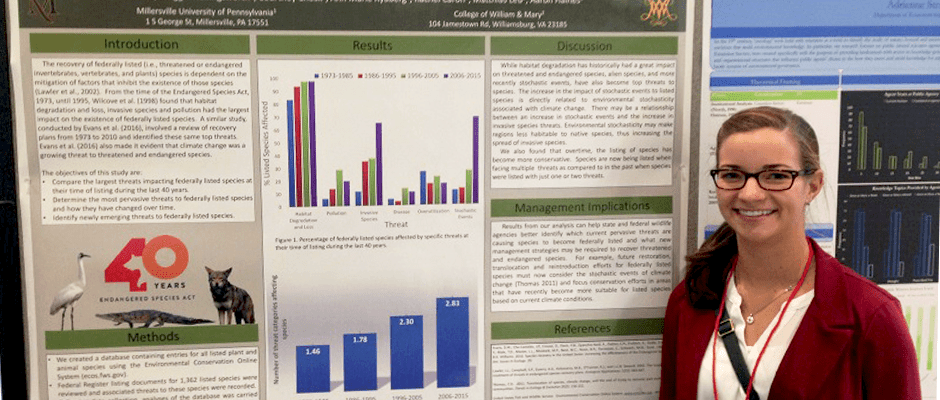Share this article
Student Poster winner: Wildlife threats over the years
Have threats to plants and wildlife changed over time? Some curious wildlife students wanted to know.
Seven undergraduate students — three at Millersville University in Pennsylvania, advised by assistant professor of conservation biology, mammalogy and ornithology Aaron Haines and four from the College of William and Mary, advised by associate professor Matthias Leu — looked through federal register documents on endangered and threatened species in the United States and recorded the reasons each species was listed. They presented their findings in the student poster session at the 2016 TWS Annual Conference in October and took home first place for their work
“It was a group effort, and basically we just started a database and listed all the species and broke it up from there,” said Kayli Thomas, an environmental biology major and a senior at Millersville. “We continued with the database until all of the plants and animal species were covered.”
In order to quantify the reasons for the species’ listings over time, the students looked at documents starting from 1973 when the Endangered Species Act went into effect through 2015. This included searching the U.S. Fish and Wildlife Service’s websites where they found PDFs of the more recent documents. However, some of the earlier documents took a little more searching and were more difficult to find on the Federal Register website, which contains government agency rules, proposed rules, and public notices, including the earliest ESA listings
“We wanted to see how [the listings] changed from the beginning of the ESA until now and where future trends may go for these species,” said Alex Sandercock, a sophomore at Millersville majoring in marine and environmental biology.
After reviewing the documents and analyzing around 1,400 species of plants and animals, the students documented and recorded the threats that led the species to be listed and then created their own categories, including habitat modification, pollution, environmental stochasticity, alien and invasive species and diseases, according to Delaney Costante, a junior studying marine and environmental biology at Millersville.
They found that the top three threats currently affecting species include habitat degradation and loss, invasive species and environmental stochasticity, or unpredictable fluctuations in environmental conditions. Overall, the team found that habitat degradation has been an issue since the beginning of the ESA and the number of listings resulting from it has not grown by much over time. However, invasive species and random environmental events have increased greatly since the beginning of the ESA.
“I think with the changing climate and the human population continuing to grow, this will help researchers and officials [in wildlife] better predict where the threats are going in the future,” Sandercock said. “It will also help identify hotspots where species are affected by certain threats to improve recovery plans to address these issues.”
The students plan to continue working on this project, including breaking the threats down into more specific categories. They also hope to use GIS technology to map the hotspots where these threats are most prevalent and provide open access to their documents so that wildlife managers can use them.
“We felt that what we were doing was important, and it surprised us to have a poster that won,” Sandercock said. “It was awesome to have that experience and see that product of all of our hard work happen.”
Header Image: Kayli Thomas stands with the poster on endangered and threatened species that won first place in the student poster contest at the TWS annual conference in Raleigh, N.C. Image courtesy of Kayli Thomas.








